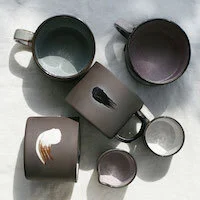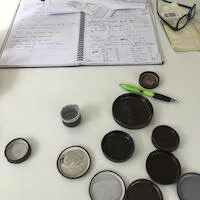When You Have To Do It Yourself
I’m not a big fan of glazes but they are at the top of my agenda. Again. I’ve added some hand built pieces to my range in addition to my slipcast pieces. Only to find that the glaze I researched, tested and tweaked to fit my casting slip doesn’t fit the hand built pieces. I should have anticipated this but I didn’t and now it’s put a major spoke in my making and selling timetable.
Kara Leigh Ford recently wrote a really interesting blog post about glazes titled ‘What no-one ever tells you about making your own pottery glazes’ in which she talks about reasons for making your own glazes or not, and a perhaps perceived snobbery in the pottery world about making your own vs off the shelf. It was an interesting read, not least because I’m a very reluctant ‘make your own glaze’ potter.
Glazes are the shiny or matt, transparent or opaque, coloured or clear finishes that most potters use on the inside and/or outside of their finished pieces. Mostly glazes cover the whole of the outside, although you might see the actual clay on the bottom where it doesn’t get glazed so it doesn’t stick to the kiln shelf.
I don’t glaze the outside of my pieces. I want to enjoy the feel, the texture, the weight, the form, with minimal distraction. They are fired to a temperature that leaves them water tight but I felt that glazing the inside of my functional pieces was necessary for more comfortable use of cutlery, ease of washing up, visibility of food and drink etc.
When I settled on using this black clay I assumed that I would just be able to find an over the counter glaze to use. I tested all the glazes and underglazes I’d accumulated over the years plus a few new ones. Many sample tests later it was clear that none of these were going to work.
I moved up to powdered glazes; the ingredients are ready mixed, you just add the appropriate amount of water to make up the glaze. Except, the appropriate amount actually depends on the exact composition of the glaze, the chemistry of the water in your area, the temperature of your bisque fire which affects the porosity of your bisque ware……Many many sample tests later it was clear that none of these were going to work either.
I dug out my one glaze book and bought/borrowed a couple more. A lovely potter friend donated an enormous amount of raw glaze materials to get me started. Some of it looked very very old. I asked whether the old stuff would still work, might it have gone off? She explained gently that since it had been sitting around in it’s original unground state as geological rock deposits for a few million years a few more years in her cupboard had probably had little effect! I gratefully took it all back to the studio.
And so it began. With Linda Bloomfield and Stephen Murfitt by my side (in spirit rather than in person) I measured, weighed and mixed. Hunched over a hundred sample pots (well actually an assortment of jam jars, coffee jars and recylced plastic containers). Muttering and tutting (difficult to swear intelligibly when your face is squashed behind an industrial standard breathing mask) and moving my finger carefully from ingredient to ingredient.
I learned that I needed to make lead and cadmium free glazes for domestic ware. I learned to avoid recipes that included Barium or Lithium since neither were effectively trapped in the fired glaze and could leach out into food after glazing.
I made, waited days for them to dry, bisque fired, glazed and glaze fired countless sample pots and sample plates so I could check runnyness and how the glaze performed in the inside corners.
My previous life as a government scientist kicked in. I made an Excel spreadsheet with all the recipes so I could calculate up the required amounts and record the outcomes. I researched recipes online. I bought more exotic ingredients with names like Silent Movie villains; Ghastly, sorry Gerstley Borate, Custer Feldspar.
Black Clay and Glazes do not get on. Glazes disappear into black clay like matter into a black hole. Yellow glazes turn blue. Transparent glazes turn orange. White glazes turn orange. Gloss glazes come out like sandpaper. Some glazes curl up into curdled puddles in disgust (crawling) because they contract more than the clay. Or they’ve been mixed too thick. A disgusting number of samples waited until they were out of the kiln before cracking in my hands as the clay contracted more than the glaze.
Many many glaze tests later (somewhere in the region of 50, I kid you not) and with some tweaking and possibly some involuntary twerking I found two potentially useful white gloss or satin base glazes that fit my black casting slip.
I really didn’t have a clue what I was doing. With a bit more knowledge the journey would have been quicker but I didn’t set out to be a glaze chemist and I still have zero interest in glazes. Luckily there are some really knowledgeable potters out there, like Linda Bloomfield. Linda not only seems to enjoy this stuff but is generous in sharing her knowledge.
I try to remember that it’s just grinding up and heating up rocks to cover another ‘rock’. It’s all just Geology.
Since my earlier fumbling efforts other potters have also discovered how uncooperative black clay is. Some suppliers have been able to suggest glazes that might rise to the challenge. Some sensible potters simply ignore glazes altogether and use slips to finish inside and out (Sage Cortez @handandfire).
It’s like so many things that come with being a self employed creative. What you don’t know, you learn. Fast. Not necessarily to expert level but enough to meet your needs. It’s a skill set I don’t think we congratulate ourselves enough for having. The persistence in problem solving, the courage to push the boundaries of our comfort zone even if it’s only a little at a time. The ability to take on and grasp new and unfamiliar skills that we then quickly take for granted! Growing a hide tough enough to recover from making what seem at the time like almighty cock-ups and get up with a sheepish grin and get on.
Anyway, enough words. I have a glaze that needs tailoring and I’m hoping that Nepheline Syenite might be the heroine that saves the day…….




